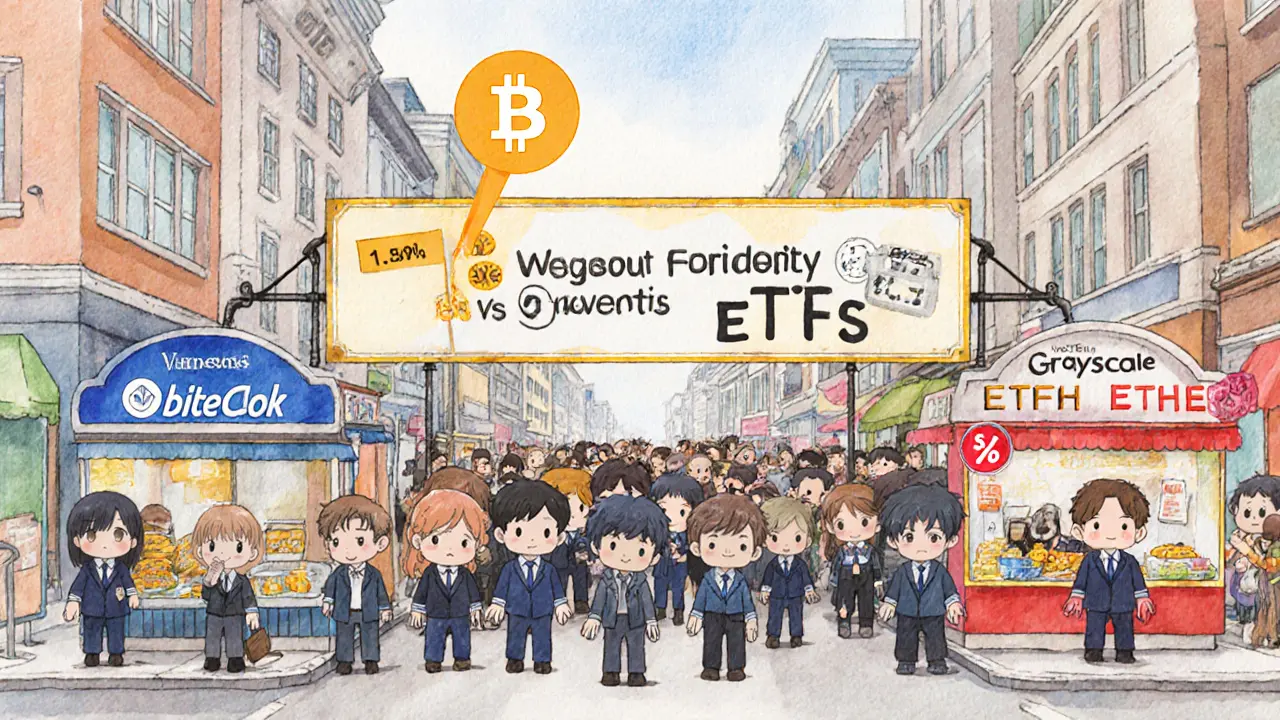Ethereum ETF Yield Calculator
Calculate Ethereum ETF Returns
Enter your investment amount to see potential returns
For over a decade, investors waited for the U.S. Securities and Exchange Commission (SEC) to say yes to a spot Bitcoin ETF. The answer didn’t come until January 10, 2024 - and then, six months later, the same thing happened with Ethereum. These weren’t just product launches. They were regulatory turning points that pulled cryptocurrency out of the shadows and into the mainstream financial system.
Why the SEC Took So Long
The SEC rejected 13 Bitcoin ETF applications between 2013 and 2023. Each time, they cited concerns about market manipulation, lack of custody, and the volatile nature of crypto. But in August 2023, a federal court ruled that the SEC had been inconsistent - approving Bitcoin futures ETFs while blocking spot ones, even though both tracked the same asset. That decision forced the SEC’s hand. By January 2024, they approved the first spot Bitcoin ETFs, including BlackRock’s IBIT and Fidelity’s FBTC. The market didn’t just react - it exploded. IBIT hit $4.6 billion in assets within its first week.What Spot ETFs Actually Are
A spot ETF lets you buy shares that directly track the price of Bitcoin or Ethereum held in secure custody. Unlike futures ETFs, which bet on future prices, spot ETFs are tied to the real-time value of the coin. You don’t need a crypto wallet. You don’t need to worry about private keys. You just buy the ETF like you’d buy Apple or Tesla stock. The ETF provider holds the actual Bitcoin or Ether, and your shares represent a claim on that asset.The Big Shift: In-Kind Creation (July 2025)
The first Bitcoin and Ethereum ETFs used a cash-only model. To create new shares, authorized participants had to buy Bitcoin or Ether on the open market and sell it for cash to fund the ETF. That created tax events, extra fees, and price distortions. It also made it hard for big holders - the so-called “whales” - to move their holdings into ETFs without selling. That changed on July 29, 2025, when the SEC approved in-kind creation and redemption. Now, institutions can swap actual Bitcoin or Ether directly for ETF shares - no cash needed. This is how gold ETFs like GLD have worked for 20 years. It’s cleaner, cheaper, and more efficient. By October 2025, BlackRock had processed over $3 billion in in-kind conversions. Bitwise and Galaxy Digital saw 47% and 63% quarter-over-quarter growth in client requests for this feature. The SEC estimated this change would save the crypto ETF market $150-250 million per year in operational costs. For big holders, it meant they could now move their crypto into a regulated, liquid vehicle without triggering capital gains taxes.
Bitcoin vs. Ethereum ETFs: Key Differences
While both are spot ETFs, they’re not the same. Bitcoin runs on proof-of-work. Ethereum runs on proof-of-stake. That small technical difference created big market consequences. Bitcoin ETFs all have identical structures: hold Bitcoin, no staking, no rewards. Simple. Transparent. Low risk. Ethereum ETFs? More complex. Since Ethereum generates staking rewards (currently around 3.5% annual yield), ETF providers had to decide: do we keep the rewards or pass them to investors? Only five of the 11 approved Ethereum ETFs chose to stake. Grayscale’s ETHE, for example, allocated 4.2% of its 3.1 million ETH holdings to staking - generating $127 million in quarterly rewards distributed to shareholders. Other providers, like VanEck’s EETH, chose not to stake at all, keeping things simpler. Fees reflect this complexity. Bitcoin ETFs average 0.25% in management fees. Fidelity’s FBTC charges 0.00%. Grayscale’s GBTC still charges 0.90% - a legacy of its old trust structure. Ethereum ETFs? They average 0.35%. Grayscale’s ETHE charges 1.50%, the highest in the market. Investors are voting with their wallets: VanEck’s EETH, with its 0.15% fee, quickly became the second-largest Ethereum ETF by AUM.Market Performance and Investor Behavior
As of September 2025, spot Bitcoin ETFs held $54.3 billion in assets. BlackRock’s IBIT led with $16.9 billion - over 30% of the total. Ethereum ETFs totaled $18.7 billion, with Grayscale’s ETHE leading at $5.1 billion. But the trends tell a more interesting story. In Q3 2025, Bitcoin ETFs saw $1.2 billion in net outflows. Ethereum ETFs saw $478 million in inflows. Why? Because Ethereum’s staking rewards offered yield in a high-interest-rate environment. Investors weren’t just buying crypto - they were buying income. Institutional behavior changed, too. A survey of 142 institutional investors found that 78% now prefer holding Bitcoin through ETFs for easier collateralization in prime brokerage deals. Reddit users praised the “regulatory clarity” but slammed Grayscale’s fees. Trustpilot reviews of Coinbase’s ETF integration showed 72% of users loved the ease of moving from self-custody to ETF exposure - but 28% struggled with the tax paperwork for in-kind conversions.
Global Ripple Effects
The U.S. didn’t act alone. In October 2025, the Hong Kong Stock Exchange launched its first spot Solana ETF - charging 0.99% annual fees. The UK’s Financial Conduct Authority lifted its four-year ban on crypto ETNs, letting firms like 21Shares and Bitwise offer physical Bitcoin and Ether products inside UK ISAs. These moves weren’t coincidental. They were responses to the U.S. approval. When Wall Street opens the door, global markets follow.What’s Next?
The SEC’s October 2025 orders didn’t just approve in-kind processing for Bitcoin and Ethereum. They said it applied to “a host of crypto asset ETPs.” That’s a green light for more. Evernorth’s $1 billion deal to acquire XRP for yield strategies hints at a possible XRP ETF. Solana’s ETF in Hong Kong is just the start - Singapore and the EU are expected to launch similar products by mid-2026. But the SEC isn’t opening the floodgates. Chairman Paul S. Atkins said clearly: “Not all crypto assets will qualify for ETP treatment under our framework.” That means each new asset - Cardano, Polkadot, Chainlink - will face its own review. The bar is higher now. You need strong custody, transparent pricing, and clear legal standing.What This Means for You
If you’re an investor, the approval of Bitcoin and Ethereum ETFs means you can now access crypto through your brokerage account - no crypto exchange needed. You get the same tax treatment as stocks. You get daily liquidity. You get institutional-grade custody. But you still need to be smart. Fees matter. Grayscale’s 1.50% fee on ETHE eats into returns. Staking rewards aren’t guaranteed - they depend on Ethereum’s network performance. And while ETFs reduce custody risk, they don’t eliminate market risk. Bitcoin and Ethereum can still crash. The real win? Regulatory clarity. For the first time, the SEC has created a path for crypto to exist within the same legal framework as stocks, bonds, and gold. That’s not just a product change. It’s a cultural shift.Are Bitcoin and Ethereum ETFs the same as buying crypto directly?
No. When you buy a Bitcoin or Ethereum ETF, you own shares in a fund that holds the actual coins. You don’t hold the private keys. You can’t send the crypto to a wallet. You trade it like a stock. It’s more convenient and regulated, but you lose direct control. If you want full ownership - like sending ETH to a DeFi protocol - you still need to buy it on an exchange.
Why do some Ethereum ETFs pay staking rewards and others don’t?
It’s a choice made by each ETF provider. Staking Ethereum generates rewards (around 3.5% per year), but it adds complexity. Providers like Grayscale chose to stake to offer yield, while others like VanEck kept it simple to avoid operational risk. If you want passive income from your Ethereum ETF, check the fund’s prospectus to see if it stakes and how often rewards are distributed.
Are Bitcoin ETFs safer than Ethereum ETFs?
Not necessarily. Both are spot ETFs with strong custody. But Ethereum ETFs have extra risk because they involve staking - which depends on the Ethereum network’s security. If staking were compromised, rewards could stop or be slashed. Bitcoin has no such mechanism. Its only risk is price volatility. So if you want simplicity and predictability, Bitcoin ETFs are safer. If you want yield and are okay with more complexity, Ethereum ETFs offer more.
Can I use my IRA or 401(k) to invest in these ETFs?
Yes. Since these are SEC-approved ETFs traded on major exchanges, they’re eligible for retirement accounts. Many brokerage platforms like Fidelity, Charles Schwab, and Vanguard now let you buy Bitcoin and Ethereum ETFs inside IRAs and 401(k)s. That’s a big deal - it means crypto is now part of mainstream retirement planning.
Will more crypto ETFs get approved?
Almost certainly. The SEC’s July and October 2025 rulings opened the door for “a host of crypto asset ETPs.” Solana’s ETF in Hong Kong is already live. Analysts expect XRP, Cardano, and Chainlink ETFs to follow, but each will need to meet the same standards: clear custody, transparent pricing, and no regulatory red flags. The SEC isn’t approving everything - just the ones that fit their new framework.
Do I pay taxes when I buy a Bitcoin ETF?
You don’t pay taxes just for buying the ETF. But if you sell it for a profit, you’ll owe capital gains tax - just like with stocks. The big change in 2025 was in-kind conversions: if you transfer Bitcoin directly into an ETF (instead of selling it for cash), you don’t trigger a taxable event. That’s huge for long-term holders. But if you sell Bitcoin to buy the ETF with cash, you owe taxes on the gain. Always check with a tax professional.



